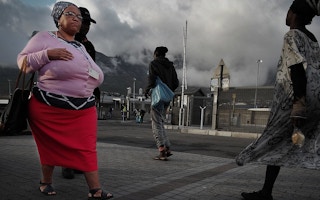The single highest barrier to development globally is neither hunger nor disease. It is gender-based discrimination and violence. That is why achieving United Nations Sustainable Development Goal 5 — gender equality and empowerment of all women and girls — is a prerequisite for progress on the other 16 SDGs.
And yet, with only a decade left to complete the SDG agenda, governments continually fail to uphold girls and women’s most basic rights, let alone empower them to reach their full potential.
Consider the plight of women in South Africa, where the femicide rate is almost five times the global average and sexual assault is rampant: in 2018-2019, the police recorded an average of 114 rapes per day — an increase of nearly 5 per cent from the previous year.
To add insult to injury, women and girls — including victims of such assaults — often lack access to sexual and reproductive health services, including safe, affordable abortion.
The problem is not legal. South Africa’s constitution guarantees access to reproductive health care, and the 1996 Choice on Termination of Pregnancy (CTOP) act allows abortion on demand up to the twelfth week of pregnancy. And yet unsafe abortions still outnumber safe abortions 2:1.
Based on South Africa’s high rate of sexual assault — and my firsthand experience as a doctor working in the country — it is fair to assume that a non-negligible share of these unwanted and unsupportable pregnancies began in violence. In this sense, many of South Africa’s women are victimised twice: first, by the perpetrators of the assault and, second, by the health system that forces them either to carry an unwanted pregnancy to term or turn to sellers of illegal abortion pills.
“
Consider the plight of women in South Africa, where the femicide rate is almost five times the global average and sexual assault is rampant: in 2018-2019, the police recorded an average of 114 rapes per day.
In the latter scenario, the women risk side effects like sepsis and hemorrhaging, and often endure the dangerous and undignified process in public bathrooms. They may then suffer yet more violence, as their community blames them for the consequences of actions taken in desperation. For example, I was recently contacted by a young woman who was being hunted by a mob that suspected her of abandoning a fetus in a public toilet.
It didn’t matter that the woman had been raped and subsequently obstructed by the local clinic staff from receiving an abortion — care guaranteed by the CTOP act. It didn’t matter that her constitutional rights had been systematically violated. She would now suffer yet more violence, unless she managed to secure safe passage away from her home.
Meanwhile, no health-care professional or support staff has ever been punished for denying abortion services in violation of the CTOP act.
These problems are systemic. A 2016 report by South Africa’s Commission on Gender Equality found that the Department of Justice was not coordinating the departments involved in implementing the Service Charter for Victims of Crime in South Africa.
The Department of Health, for its part, had not established a standardised system for funding, monitoring, and evaluating the delivery of health-care services to victims. The consequences of these failures included shortages of DNA evidence kits at police stations, inadequate transport resources, and a lack of safe houses for victims. Perhaps not surprisingly, perpetrators of sexual violence are rarely punished.
These problems are hardly unique to South Africa. The World Health Organization estimates that, globally, more than one in three (35 per cent) women will experience physical or sexual intimate-partner violence or non-partner sexual violence in their lifetime.
Few see their attackers punished, and many cannot access sexual and reproductive health care after the fact, even in countries that have ratified international instruments guaranteeing the right to such care.
In 2015, the WHO and other United Nations agencies attempted to help address these lapses with the Essential Services Package for Women and Girls Subject to Violence. The package serves as a tool to identify what countries’ health, social services, police, and justice sectors must provide to all women and girls who have experienced gender-based violence, and lays out guidelines for coordination.
By implementing the package’s recommendations, countries would be better able to fulfill their commitments under regional and international frameworks, such as the 2030 Agenda for Sustainable Development (which encompasses the SDGs). This would also support national-level efforts, such as proper enforcement of South Africa’s CTOP act.
Failure to take such steps is exacting a devastating physical, psychological, social, and economic toll on countries. As a 2013 WHO report notes, violence against women leads to death, injury, and unwanted pregnancy, with higher rates of infant and child mortality.
Moreover, victims often face depression, social isolation, and excessive alcohol use, all of which impairs their ability to work, leading to lost income. In the European Union, gender-based violence is estimated to cost nearly €256 billion ($280 billion) per year. In South Africa, that figure stands at 28.4 billion rand ($1.9 billion).
Modern development strategies often recognise the pivotal importance of enabling women to fulfill their potential and contribute effectively to their economies. Yet they fail to recognise the need for concerted action to protect women from violence, and uphold the rights of victims. They are thus grossly inadequate.
Women deserve to be safe in their homes, at school or work, in hospitals, and on the streets. Only when they are not struggling to survive can they — and their communities — truly thrive.
Tlaleng Mofokeng, a member of the Commission for Gender Equality in South Africa, is an expert in sexual and reproductive health and rights and the author of Dr T: A Guide to Sexual Health and Pleasure.









